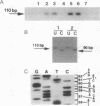Abstract
An activated Ha-ras oncogene has been consistently found in chemically initiated benign and malignant mouse skin tumors, and an activated ras oncogene has been shown to initiate the process of mouse skin carcinogenesis. However, the exact timing of mutational activation of the Ha-ras gene relative to application of the chemical carcinogen is not known. A sensitive mutation-specific PCR technique was used to experimentally address the timing of Ha-ras gene mutational activation. This technique can detect mutant Ha-ras alleles in the presence of a very large excess of normal ras alleles. Activated Ha-ras genes with 61st codon A----T mutations were found in the epidermis of mice 1 week after topical initiation with 7,12-dimethylbenz[a]anthracene or urethane by using this assay. These results were confirmed by Xba I restriction fragment length polymorphism analysis and direct DNA sequencing. One week after initiation is 1-2 months before the appearance of benign papillomas that harbor activated Ha-ras oncogenes when the initiated mice are promoted with the tumor promoter phorbol 12-myristate 13-acetate. Our data support the hypothesis that initiated epidermal cells containing an activated Ha-ras gene can remain dormant in the skin until a tumor promoter induces regenerative hyperplasia that allows for outgrowth of these cells with an activated ras oncogene to give rise to a benign papilloma.
Full text
PDF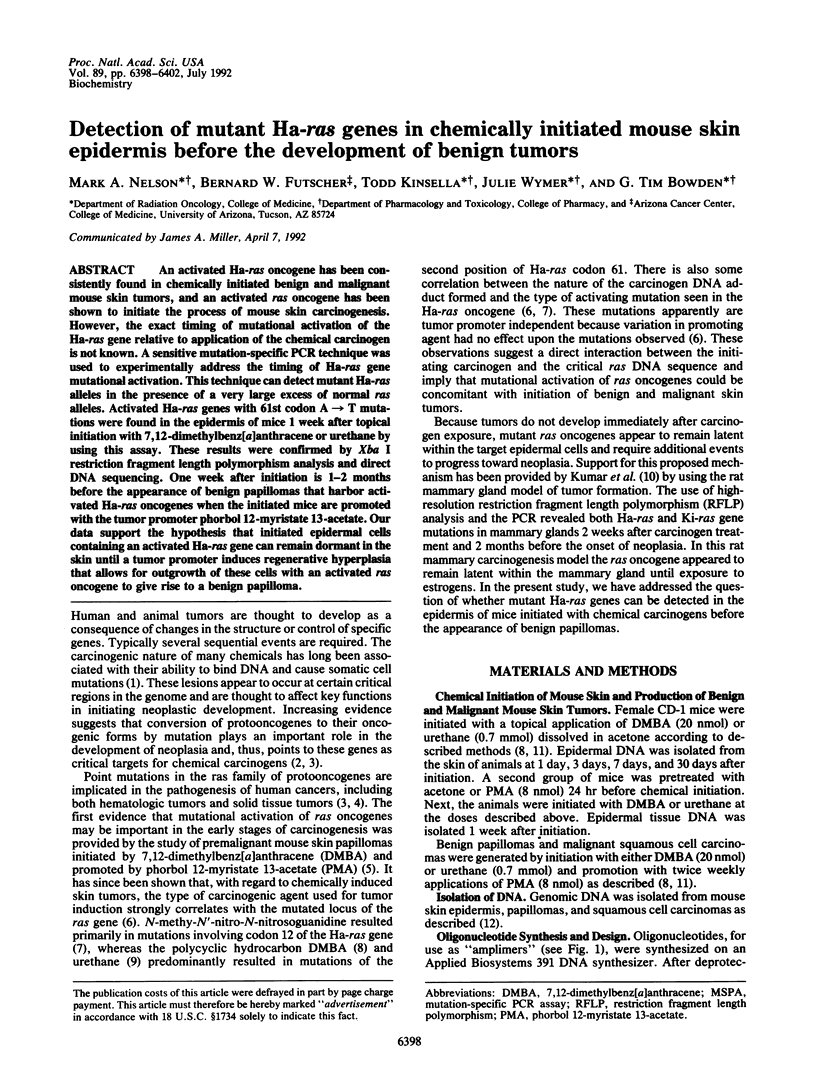
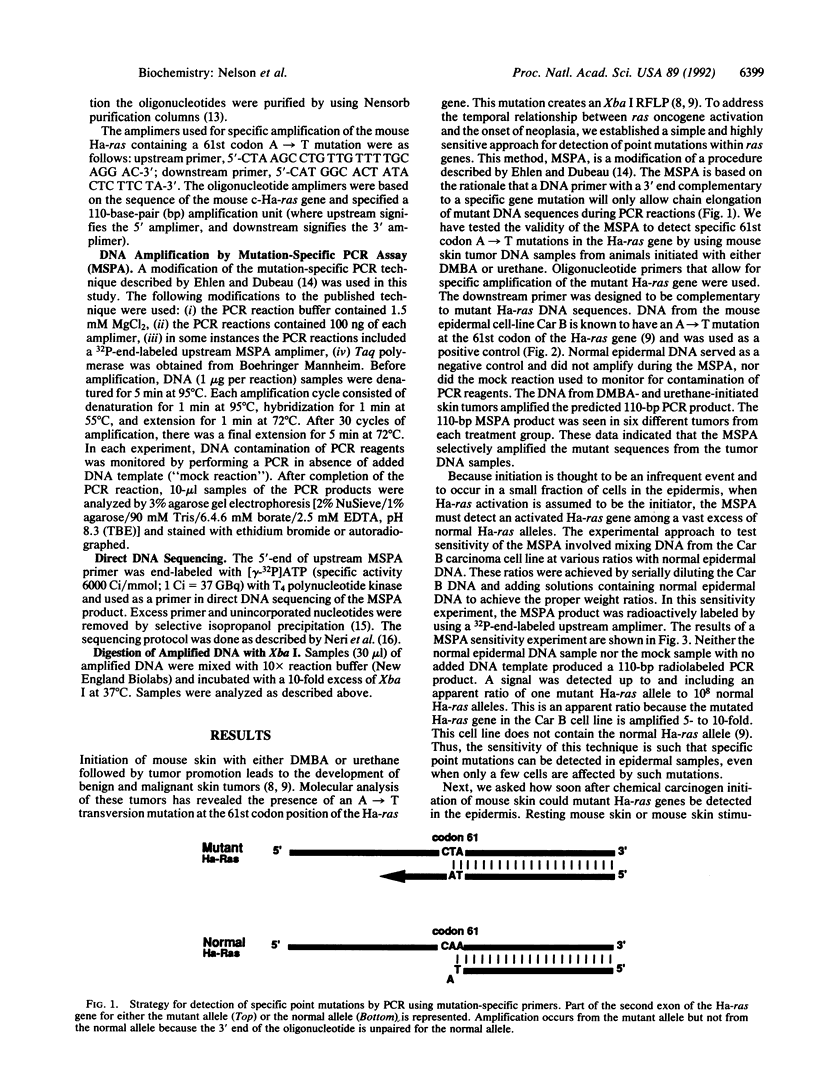
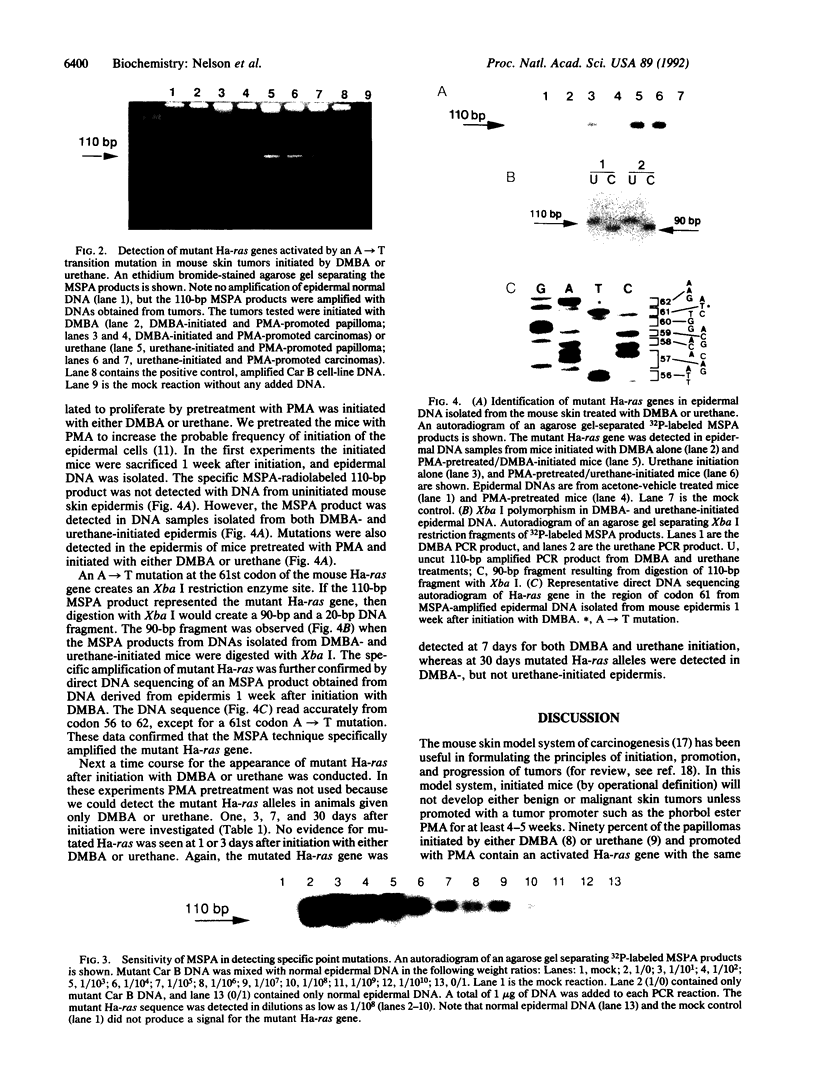
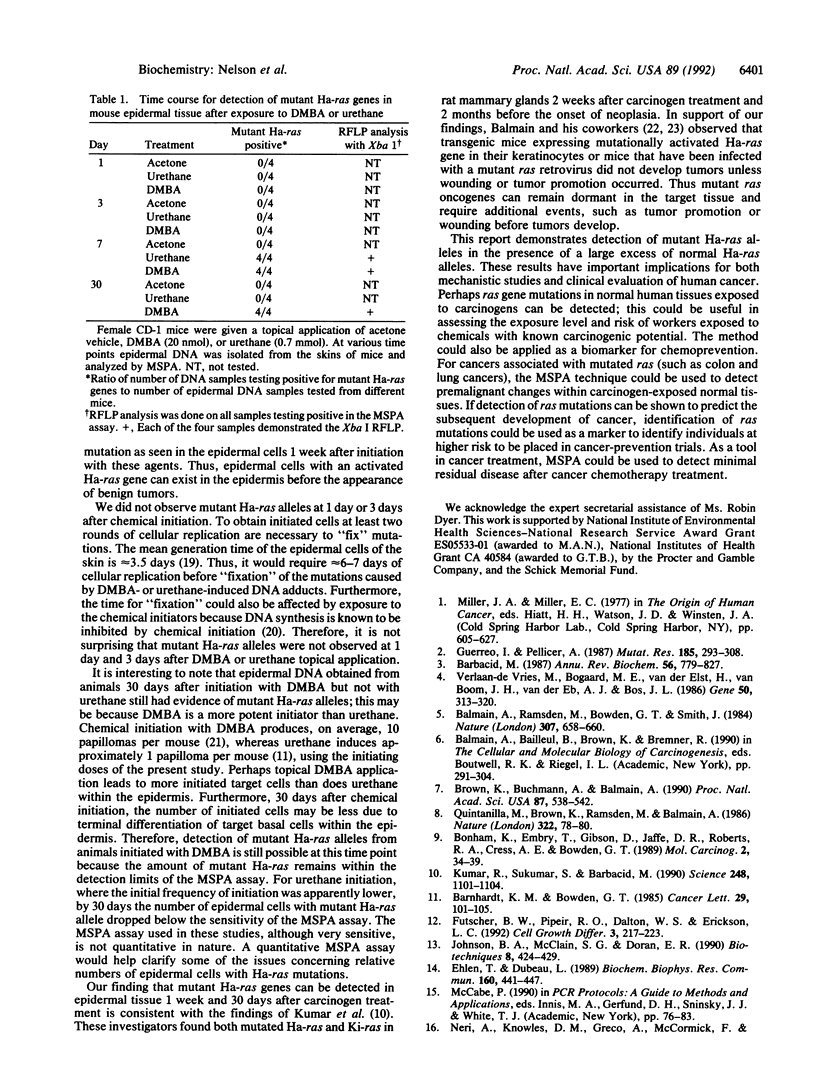
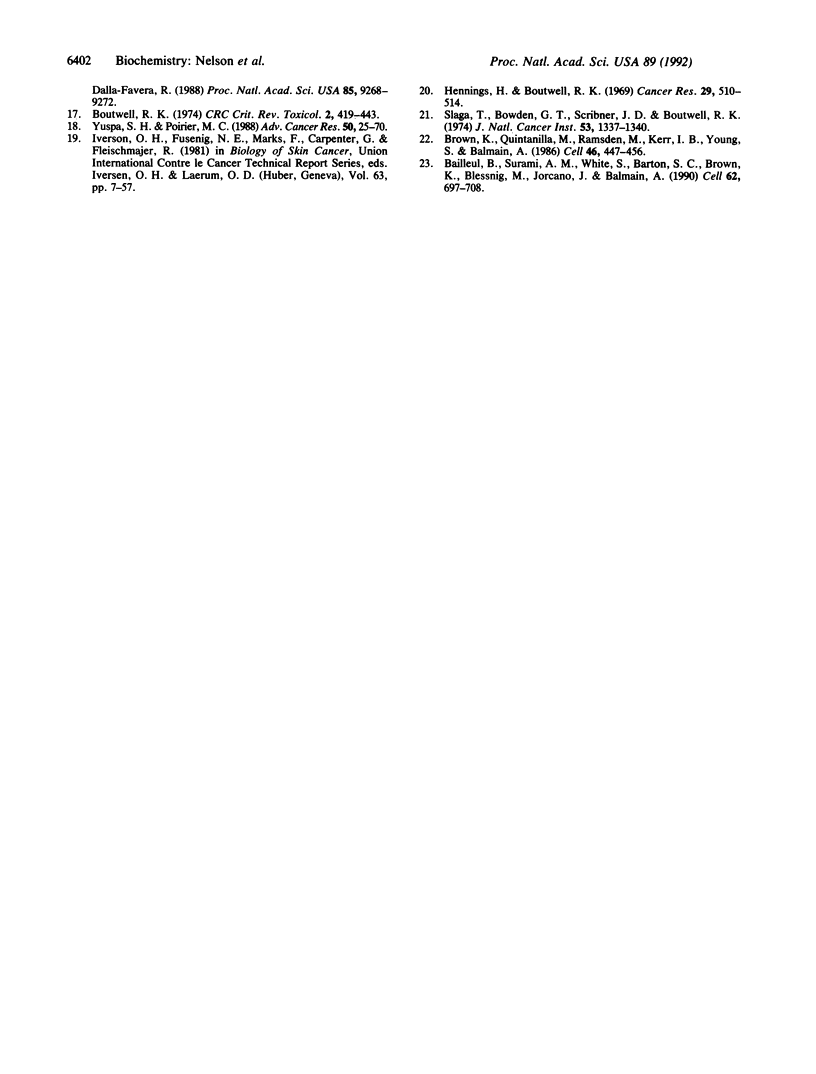
Images in this article
Selected References
These references are in PubMed. This may not be the complete list of references from this article.
- Bailleul B., Surani M. A., White S., Barton S. C., Brown K., Blessing M., Jorcano J., Balmain A. Skin hyperkeratosis and papilloma formation in transgenic mice expressing a ras oncogene from a suprabasal keratin promoter. Cell. 1990 Aug 24;62(4):697–708. doi: 10.1016/0092-8674(90)90115-u. [DOI] [PubMed] [Google Scholar]
- Balmain A., Ramsden M., Bowden G. T., Smith J. Activation of the mouse cellular Harvey-ras gene in chemically induced benign skin papillomas. Nature. 1984 Feb 16;307(5952):658–660. doi: 10.1038/307658a0. [DOI] [PubMed] [Google Scholar]
- Barbacid M. ras genes. Annu Rev Biochem. 1987;56:779–827. doi: 10.1146/annurev.bi.56.070187.004023. [DOI] [PubMed] [Google Scholar]
- Barnhart K. M., Bowden G. T. Cisplatin as an initiating agent in two-stage mouse skin carcinogenesis. Cancer Lett. 1985 Oct;29(1):101–105. doi: 10.1016/0304-3835(85)90129-6. [DOI] [PubMed] [Google Scholar]
- Bonham K., Embry T., Gibson D., Jaffe D. R., Roberts R. A., Cress A. E., Bowden G. T. Activation of the cellular Harvey ras gene in mouse skin tumors initiated with urethane. Mol Carcinog. 1989;2(1):34–39. doi: 10.1002/mc.2940020106. [DOI] [PubMed] [Google Scholar]
- Boutwell R. K. The function and mechanism of promoters of carcinogenesis. CRC Crit Rev Toxicol. 1974 Jan;2(4):419–443. doi: 10.3109/10408447309025704. [DOI] [PubMed] [Google Scholar]
- Brown K., Buchmann A., Balmain A. Carcinogen-induced mutations in the mouse c-Ha-ras gene provide evidence of multiple pathways for tumor progression. Proc Natl Acad Sci U S A. 1990 Jan;87(2):538–542. doi: 10.1073/pnas.87.2.538. [DOI] [PMC free article] [PubMed] [Google Scholar]
- Brown K., Quintanilla M., Ramsden M., Kerr I. B., Young S., Balmain A. v-ras genes from Harvey and BALB murine sarcoma viruses can act as initiators of two-stage mouse skin carcinogenesis. Cell. 1986 Aug 1;46(3):447–456. doi: 10.1016/0092-8674(86)90665-3. [DOI] [PubMed] [Google Scholar]
- Ehlen T., Dubeau L. Detection of ras point mutations by polymerase chain reaction using mutation-specific, inosine-containing oligonucleotide primers. Biochem Biophys Res Commun. 1989 Apr 28;160(2):441–447. doi: 10.1016/0006-291x(89)92452-2. [DOI] [PubMed] [Google Scholar]
- Futscher B. W., Pieper R. O., Dalton W. S., Erickson L. C. Gene-specific DNA interstrand cross-links produced by nitrogen mustard in the human tumor cell line Colo320HSR. Cell Growth Differ. 1992 Apr;3(4):217–223. [PubMed] [Google Scholar]
- Guerrero I., Pellicer A. Mutational activation of oncogenes in animal model systems of carcinogenesis. Mutat Res. 1987 May;185(3):293–308. doi: 10.1016/0165-1110(87)90021-2. [DOI] [PubMed] [Google Scholar]
- Hennings H., Boutwell R. K. The inhibition of DNA synthesis by initiators of mouse skin tumorigenesis. Cancer Res. 1969 Mar;29(3):510–514. [PubMed] [Google Scholar]
- Johnson B. A., McClain S. G., Doran E. R., Tice G., Kirsch M. A. Rapid purification of synthetic oligonucleotides: a convenient alternative to high-performance liquid chromatography and polyacrylamide gel electrophoresis. Biotechniques. 1990 Apr;8(4):424–429. [PubMed] [Google Scholar]
- Kumar R., Sukumar S., Barbacid M. Activation of ras oncogenes preceding the onset of neoplasia. Science. 1990 Jun 1;248(4959):1101–1104. doi: 10.1126/science.2188364. [DOI] [PubMed] [Google Scholar]
- Neri A., Knowles D. M., Greco A., McCormick F., Dalla-Favera R. Analysis of RAS oncogene mutations in human lymphoid malignancies. Proc Natl Acad Sci U S A. 1988 Dec;85(23):9268–9272. doi: 10.1073/pnas.85.23.9268. [DOI] [PMC free article] [PubMed] [Google Scholar]
- Quintanilla M., Brown K., Ramsden M., Balmain A. Carcinogen-specific mutation and amplification of Ha-ras during mouse skin carcinogenesis. Nature. 1986 Jul 3;322(6074):78–80. doi: 10.1038/322078a0. [DOI] [PubMed] [Google Scholar]
- Slaga T. J., Bowden G. T., Scribner J. D., Boutwell R. K. Dose-response studies on the ability of 7,12-dimethylbenz(alpha)anthracene and benz(alpha)anthracene to initiate skin tumors. J Natl Cancer Inst. 1974 Nov;53(5):1337–1340. doi: 10.1093/jnci/53.5.1337. [DOI] [PubMed] [Google Scholar]
- Verlaan-de Vries M., Bogaard M. E., van den Elst H., van Boom J. H., van der Eb A. J., Bos J. L. A dot-blot screening procedure for mutated ras oncogenes using synthetic oligodeoxynucleotides. Gene. 1986;50(1-3):313–320. doi: 10.1016/0378-1119(86)90335-5. [DOI] [PubMed] [Google Scholar]
- Yuspa S. H., Poirier M. C. Chemical carcinogenesis: from animal models to molecular models in one decade. Adv Cancer Res. 1988;50:25–70. doi: 10.1016/s0065-230x(08)60434-0. [DOI] [PubMed] [Google Scholar]



